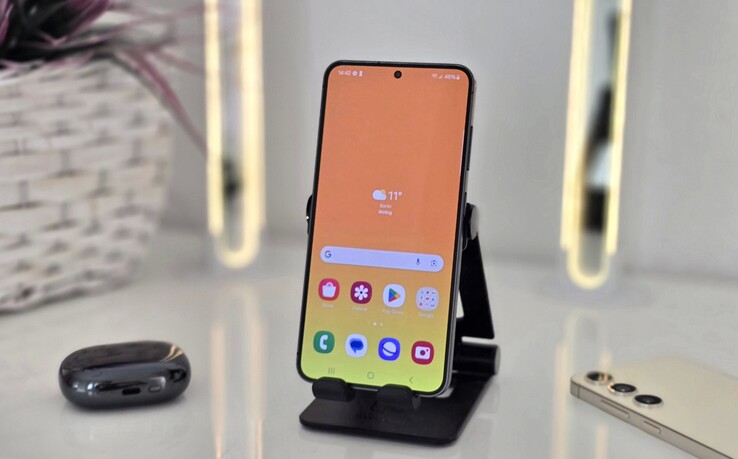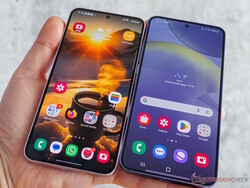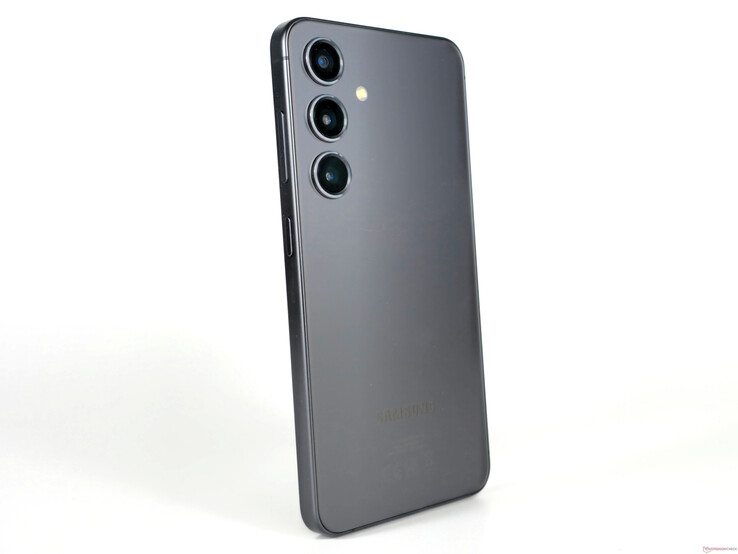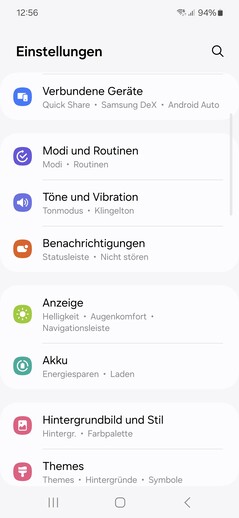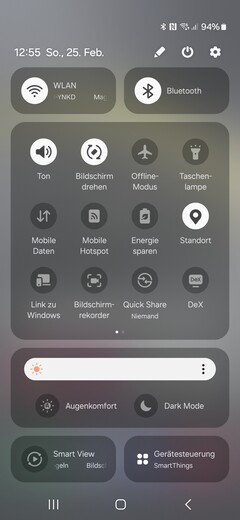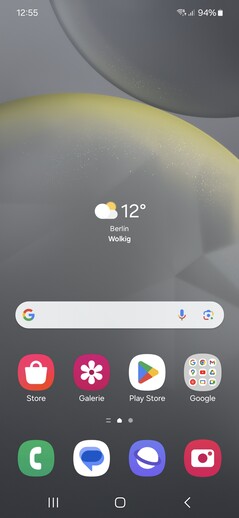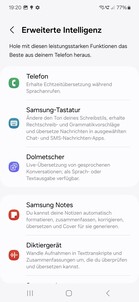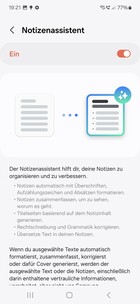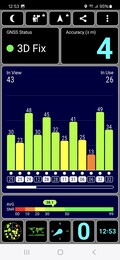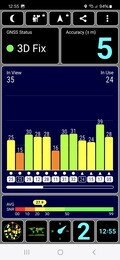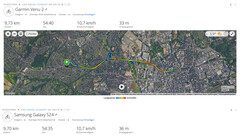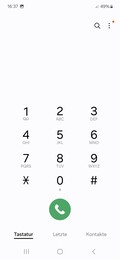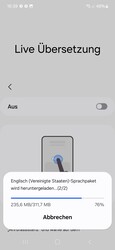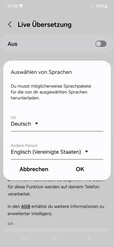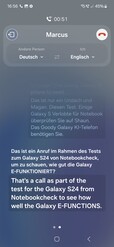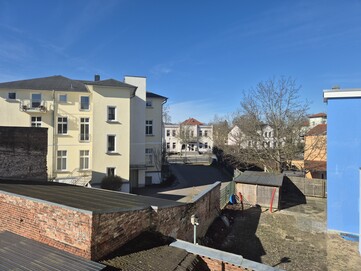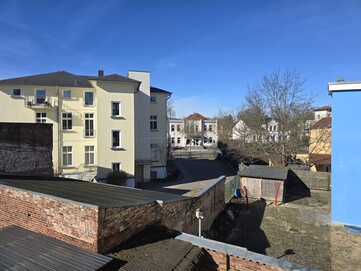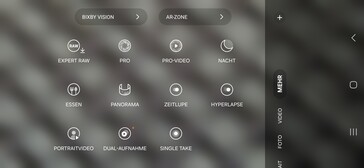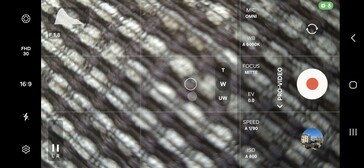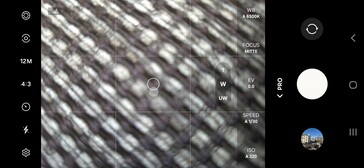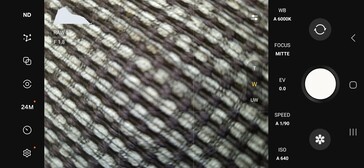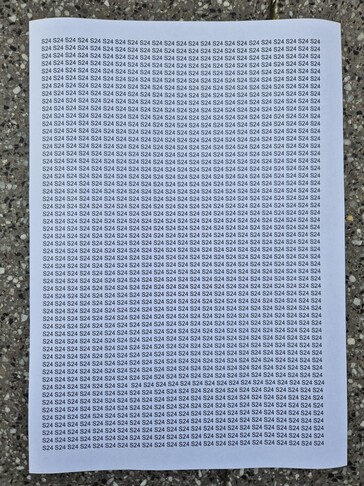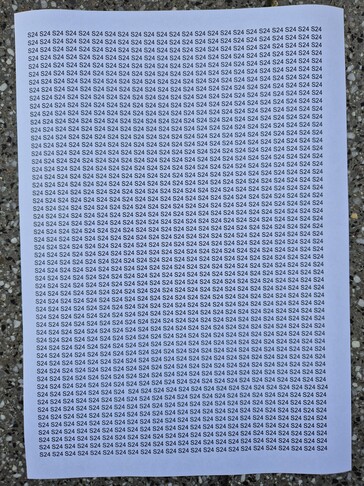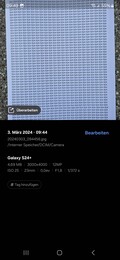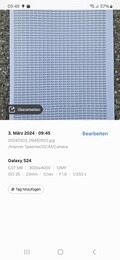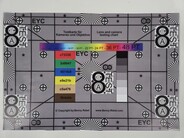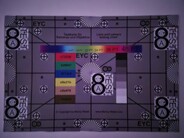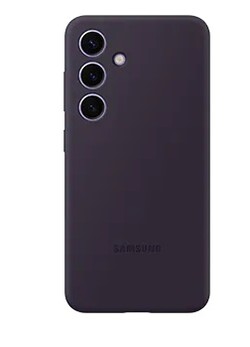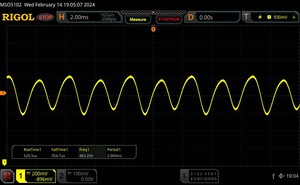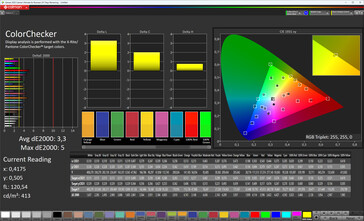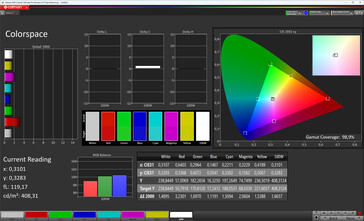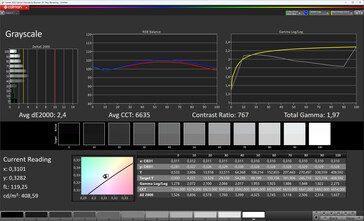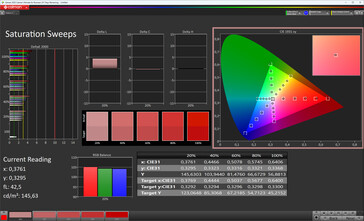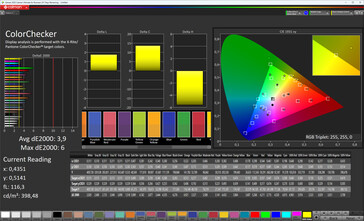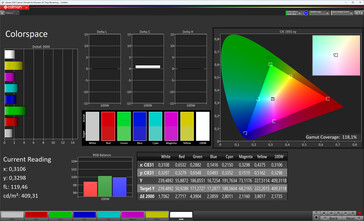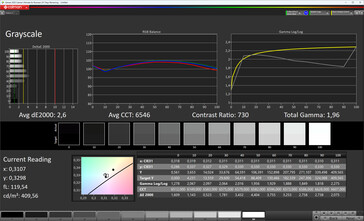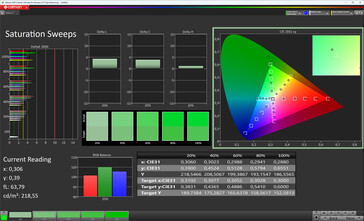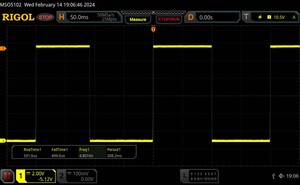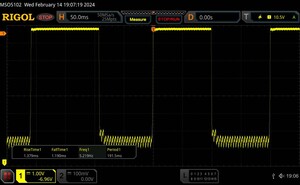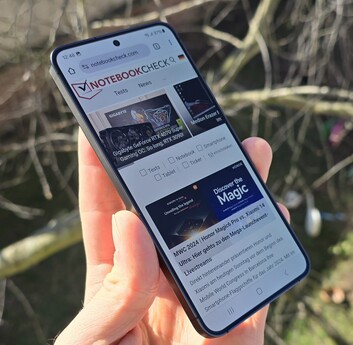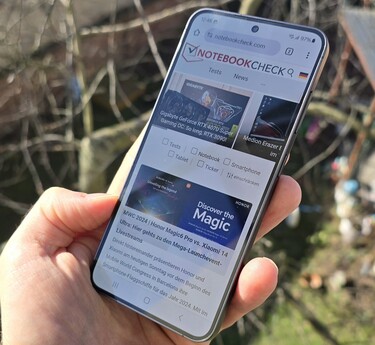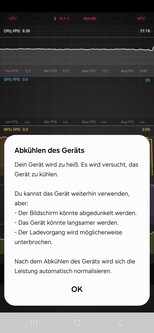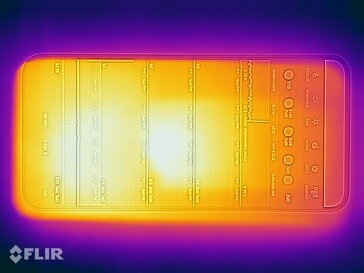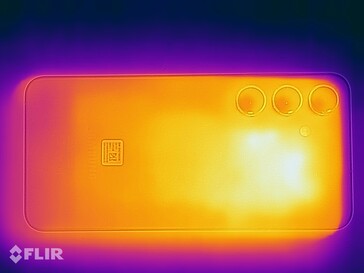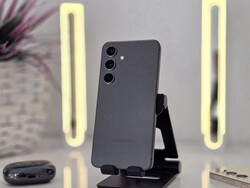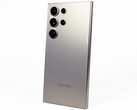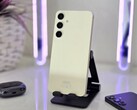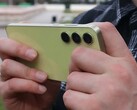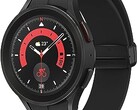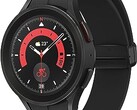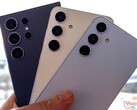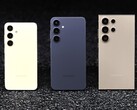Samsung Galaxy S24 review - The best small Android smartphone gets cheaper but not better
As part of the Unpacked event in January 2024, Samsung presented two new top-of-the-range smartphones, the Galaxy S24 and Galaxy S24+ to add to the flagship of the Galaxy S series. What both Samsung smartphones have in common is an in-house chipset and, unlike the previous year, only the Ultra model uses the Qualcomm Snapdragon 8 Gen 3 for Galaxy. At the top end, Samsung, at least in Europe, has gone with the Exynos 2400 which, on paper, also brings tons of power to the table.
In its basic configuration with 128 GB of internal memory, the smaller, 6.2-inch Samsung Galaxy S24 starts with an RRP of $799 making it $50 cheaper than its predecessor. The latter can probably be justified by a lack of big hardware differences compared to the Galaxy S23. By contrast, the 2024 model's focus is on another area: the software - especially Galaxy AI and sustainability.
Possible competitors compared
Rating | Date | Model | Weight | Drive | Size | Resolution | Best Price |
|---|---|---|---|---|---|---|---|
| 90 % | 03/2024 | Samsung Galaxy S24 Exynos 2400, Xclipse 940 | 167 g | 256 GB UFS 4.0 Flash | 6.20" | 2340x1080 | |
| 90.5 % | 03/2023 | Samsung Galaxy S23 SD 8 Gen 2 for Galaxy, Adreno 740 | 167 g | 128 GB UFS 3.1 Flash | 6.10" | 2340x1080 | |
| 89.8 % | 01/2024 | Xiaomi 14 SD 8 Gen 3, Adreno 750 | 193 g | 256 GB UFS 4.0 Flash | 6.36" | 2670x1200 | |
| 89.1 % | 10/2023 | Apple iPhone 15 A16, A16 GPU 5-Core | 171 g | 128 GB NVMe | 6.10" | 2556x1179 | |
| 88.9 % | 11/2023 | Google Pixel 8 Tensor G3, Mali-G715 MP7 | 187 g | 128 GB UFS 3.1 Flash | 6.20" | 2400x1080 |
Case - The Samsung Galaxy S24 has grown marginally
At 167 grams and with a case width of 70.6 millimeters, the Galaxy S24 is a light and, above all, compact smartphone. In terms of the design language, Samsung has stuck to its guns so, from a visual point of view, the Galaxy has hardly changed compared to its predecessor. Only the frame is no longer rounded and now looks somewhat squarer. The 6.2-inch Samsung Galaxy S24 has almost identical external dimensions but has still managed to grow by around 0.1 of an inch. At 90.9 percent, this makes the screen-to-body ratio a touch more efficient. The display and rear of the device are both protected by Corning Gorilla Glass Victus 2.
Potential S24 buyers are provided with a large selection of colors which are inspired by earth minerals, according to information from the manufacturer. In addition to Onyx Black, Marble Gray, Cobalt Violet and Amber Yellow, the Galaxy phone is also exclusively available in Jade Green, Sandstone Orange and Sapphire Blue in the Samsung store. Due to its matte surface, the Galaxy S24 appears to be less prone to fingerprints, but faint greasy streaks are visible.
The build quality is on a wonderfully high level, the gap dimensions are tight and flush. The transition between the rear of the case and the side Armor aluminum frame is seamless and the case feels very premium in the hand. Likewise, the Galaxy S24 is IP68-certified which means cleaning the device under water or using it during a rain shower shouldn't present any problems.
Features - The Galaxy S24 comes with UFS storage
All in all, the Galaxy S24 offers a very good feature set but the Samsung smartphone stops short of offering everything. For example, an ultra-wideband chip is missing and this would have allowed the use of digital keys with the smallest phone in the Galaxy S24 series. The device also lacks the newest Bluetooth version (5.4) which means the handset continues to use the 5.3 standards used by its predecessor. In contrast to the Galaxy S24 Ultra model with the Qualcomm chipset, the Exynos 2400-powered S24 model also doesn't have the cross-platform "Snapdragon Seamless" feature on board, although, in future, a wireless connection between various operating systems such as Android and Windows is said to be possible.
Similar to its predecessor, only two storage sizes are available - 128 GB and 256 GB. A 512 GB option continues to be absent. The smaller variant still uses the slower UFS 3.1 standard because the UFS 4.0 found in our 256 GB review version isn't manufactured with such small capacities. Just as with the audio jack, you'll have to do without optional memory expansion.
By contrast, hardly any compromises have had to be made with the USB port since, following the specifications, it uses USB 3.2 (Gen. 1). In addition, USB OTG and wired image output are supported. In our copy test using an M2 SSD (Samsung 980 Pro), the (normally) fast SSD's transfer speeds are, at 188 MB/s, rather slow. The Samsung smartphone has no problems dealing with the exFAT file system, although, an NTFS formatted storage device can only be read and not written to.
Software - A Samsung smartphone with long updates
One of the highlights is the guarantee of long updates that Samsung awards its Galaxy S series. With the Galaxy S24, the Korean manufacturer has gone the extra mile and has given its top-end smartphone not only seven years of security updates but also seven Android generations. In addition, security updates are said to receive a monthly rollout although the manufacturer doesn't state for how long.
At the time of testing, the operating system is based on the current Android 14 and the security patch level is from February 2024. Layered on top of this is version 6.1 of the manufacturer's in-house One UI.
In addition to changes to the lock screen and the Always On display, One UI 6.1 is shorthand for the new "Galaxy AI". This means Samsung is implementing some functions that are supposed to do their work smartly thanks to artificial intelligence – however, many features such as the real-time translator or writing assistant require an internet connection for optimum results. "Circle to Search", with which objects can be searched for from the display with the help of Google algorithms, requires an active online connection.
Communication and GNSS - The Galaxy S24 and Wi-Fi 6E
The 5G standard is supported with many frequencies in Samsung's top league, albeit without mmWave support in Europe. The 4G network frequency spectrum is also very broad - access to numerous and all German language-relevant LTE bands is offered. The Galaxy phone is also perfectly equipped for an overseas stay.
Since the installed Exynos 2400 is unable to make a connection to a WiFi 7 network, the Galaxy S24 only supports WiFi 6E. Interestingly, Samsung has also additionally decided to deactivate the be-standard in models which house the Snapdragon 8 Gen 3 sold outside Europe.
However, with WiFi 6E, high speeds in the 6 GHz range are possible, providing it has the according tech counterpart but, with our Asus ROG Rapture GT-AXE11000 reference router, the Galaxy S24's transfer speeds are significantly slower than the predecessor. On the one hand, this is because we were unable to connect the Galaxy S24 to 6 GHz Wi-Fi. On the other hand, with an active 5 GHz connection we only measured between 700 and 900 MBit/s which indicates that the VHT160 channel was not integrated. The transfer speeds are mostly stable.
| Networking | |
| Samsung Galaxy S24 | |
| iperf3 receive AXE11000 |
|
| iperf3 transmit AXE11000 |
|
| Samsung Galaxy S23 | |
| iperf3 receive AXE11000 |
|
| iperf3 transmit AXE11000 |
|
| iperf3 transmit AXE11000 6GHz |
|
| iperf3 receive AXE11000 6GHz |
|
| Xiaomi 14 | |
| iperf3 receive AXE11000 |
|
| iperf3 transmit AXE11000 |
|
| iperf3 transmit AXE11000 6GHz |
|
| iperf3 receive AXE11000 6GHz |
|
| Apple iPhone 15 | |
| iperf3 receive AXE11000 |
|
| iperf3 transmit AXE11000 |
|
| Google Pixel 8 | |
| iperf3 receive AXE11000 |
|
| iperf3 transmit AXE11000 |
|
| iperf3 transmit AXE11000 6GHz |
|
| iperf3 receive AXE11000 6GHz |
|
| Average of class Smartphone | |
| iperf3 receive AXE11000 |
|
| iperf3 transmit AXE11000 |
|
| iperf3 transmit AXE11000 6GHz |
|
| iperf3 receive AXE11000 6GHz |
|
When it comes to positioning, the Galaxy S24 relies on the main satellite systems, mostly in dual-band. We were able to connect the "GPS Test“ and "GPSTest" applications to Beidou (B1(C), B2a), GPS (L1, L5), Galileo (E1, E5a) and GLONASS system (L1) with a high level of accuracy, even indoors.
The location determination in our real-world test was not always perfect but still very good. Although small deviations from the planned route were noticeable, the Garmin Venu 2 we used for comparison purposes sometimes recorded the route more inaccurately.
Telephone functions and voice quailty - The Samsung phone offers live translation
The Galaxy S24 supports two nano SIM cards including 5G use for both slots as well as the VoLTE or Wi-Fi call standards. Unlike the predecessor, a dual eSIM function is also on board.
The voice quality is very natural and voices are reproduced clearly. Our counterpart was also able to characterize the Samsung handset as clear and understandable. Our conversation experience was free of minor background noises.
The new Galaxy AI is also at work during telephone calls. With the "Live Translation" function, the Galaxy S24 translates phone calls made via the Samsung telephone app in real-time – and it does this directly on the Galaxy smartphone without a data connection. However, "real-time" is a very flexible term since it sometimes takes one or two seconds before short language content is translated. There were (still) long pauses, especially when the original voices were removed. On the whole, Live Translation is a very interesting and, above all, useful everyday function.
Cameras - No big changes to the Samsung Galaxy S23
The Galaxy S23's "proven" camera system can be found once more in an almost unchanged form in the 2024 model. The front camera has autofocus and offers a resolution of 12 MPix, many settings possibilities as well as filters and can record videos in Ultra HD at up to 60 frames per second. The f/2.2 lens delivers nice selfies with balanced exposure and good sharpness in daylight.
The Galaxy S24's main camera is based on the tried and trusted Samsung ISOCELL GN3 found in both the predecessor and pre-predecessor and not the rumoured new ISOCELL GNK. The 1/1.57-inch camera sensor takes 12.5 MPix photos in 4-in-1 pixel binning, as standard, and offers optical image stabilization. Additionally, in pro mode, the user has both a 50 MPix as well as a new 24 MPix photo option at their disposal.
Photos taken with the 50 MPix lens are impressive with beautiful dynamics and natural color balance although details do get lost toward the edges due to increasing blurriness. Furthermore, the images appear a little oversharpened. Low-light conditions produce softer contours in the motifs, however, the lighting is very appealing and we were also taken by the exposure quality and level of detail in low-light photos, especially for the price category.
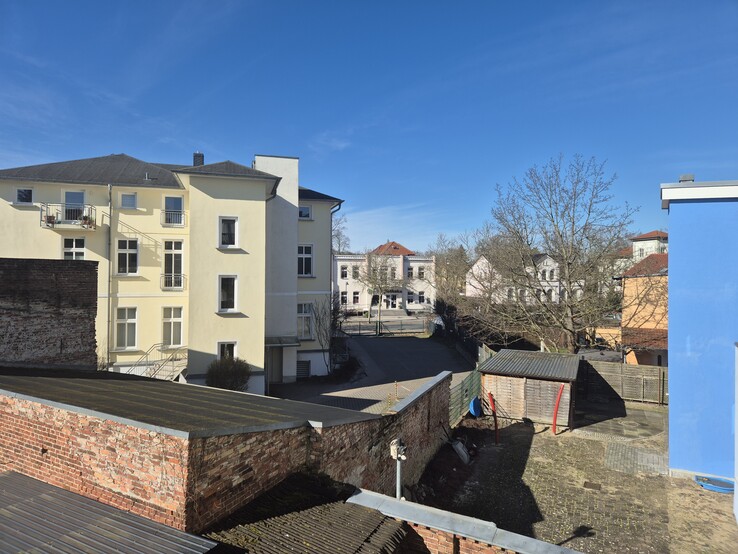
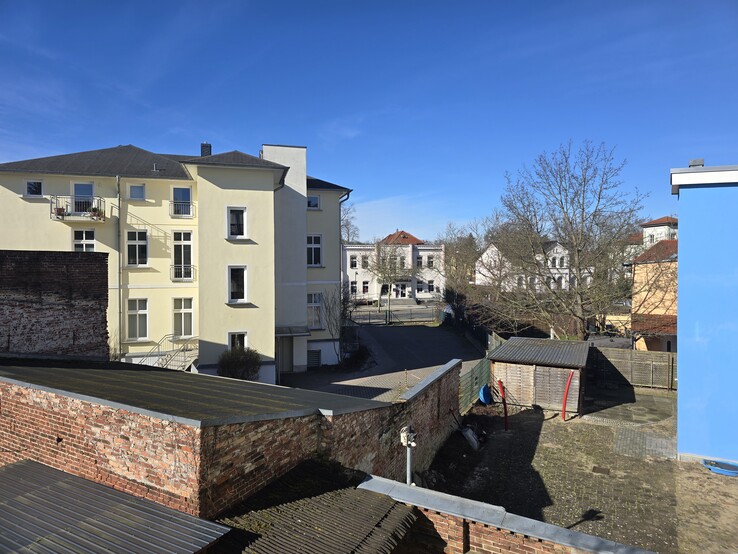
The ultra wide-angle lens offers decent photo quality but one or two image flaws creep into the Galaxy S24's shots. Outside the center of the image, the 12 MPix lens also reveals a pronounced blurriness which is accompanied by image noise.
We are happier with the third lens in the group. This one has 3x, lossless magnification and optical image stabilization. In good light, the zoom photos offer solid sharpness up to 10x but, beyond 3x, details quickly get lost due to the digital magnification. The maximum zoom is 30x but only contours can be seen here. In low-light situations, the 10 MPix lens and its f/2.4 aperture appear very noisy.
In terms of videos, the top-tier Samsung phone provides good stabilization thanks to its OIS. Moving images can be recorded in FullHD (max. 120fps) as well as in UHD quality (max. 60fps) and, if desired, also at up to 30 frames per second in 8K. In addition, many settings can also be made manually via the camera software ("Video Profile“) and the 21:9 image format can also be selected.
Galaxy AI's new ProVisual engine is set to work in the areas of camera and photo processing. New content can be created in a photo when editing images thanks to generative artificial intelligence. It works in real-time but is often less than "intelligent" and, for this reason, it currently enjoys more of a beta status. At this point in time, Galaxy AI is neither really practical nor suitable for everyday tasks relating to image processing.
Update from March 4, 2024:
After some Galaxy S23 series devices were affected by a partial banana-shaped blur and users in forums are now complaining about this problem in the 2024 models, we took a look at our two Galaxy S24 review samples. The images were recorded at ISO 25 in very good lighting conditions to see whether any areas appeared particularly out of focus.
With both the Galaxy S24 and the Galaxy S24+, there is no real visible blurring problem in the photographed text. While the sharpness of the Plus model is quite homogeneous, a small spot of blur can be seen in the right image area of our Galaxy S24. However, this is not comparable to the blur pattern in our Galaxy S23+ test photos.
We cannot therefore confirm the predecessor’s “banana gate” based on our two review devices.
Image Comparison
Choose a scene and navigate within the first image. One click changes the position on touchscreens. One click on the zoomed-in image opens the original in a new window. The first image shows the scaled photograph of the test device.
In our measurements under controlled lighting conditions, the Galaxy S24 demonstrates very decent color reproduction. In particular, green areas are displayed brighter than the reference color but, despite this, the DeltaE deviations are still on a low level overall.
At full size, the details in our test chart appear nicely sharp and color gradients are reproduced very cleanly. The 50 MPix sensor only reveals some blurriness at the edges and the board's fine texture is lost.
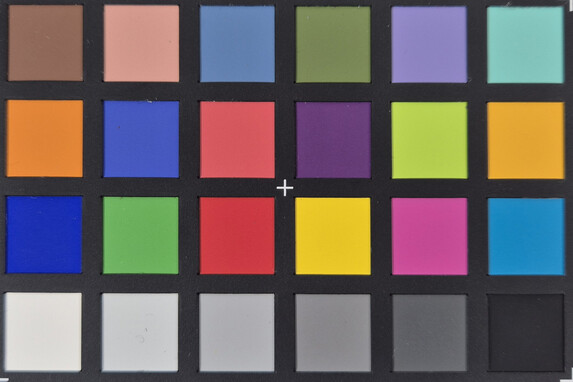
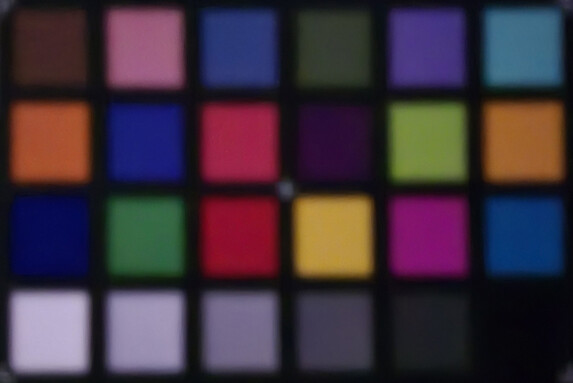
Accessories and warranty - The Galaxy smartphone comes without a charger
According to Samsung, the Galaxy S24 comes packaged in 100 percent recycled paper and cardboard. But, you can't say the box contains much in the way of accessories - a USB-C cable and a SIM tool as well as info booklets. An optional 25-watt charger can be purchased in the Samsung Shop (RRP: $20). The same applies to a variety of matching cases.
In Germany, Samsung provides its cell phones with a 24-month warranty and offers every Galaxy S24 buyer the Care+ insurance package. This gives the Galaxy S24 up to two years of cover against damage and theft. Depending on the chosen package, prices range between 79 and 229 euros (around $75 and $200 respectively). There is an excess of 59 and 99 euros (approximately $55 and $95 respectively) for damage and theft claims, respectively.
Input devices & operation - The Galaxy S24 has Face Unlock
The 6.2-inch OLED display comes with a factory-fitted screen protector and inputs thereon are implemented accurately. With a 240 Hz sampling rate, the LTPO panel responds quickly with high touch sensitivity. In everyday use, the Galaxy S24 feels very snappy with the device hardly ever lagging. A slight stutter only appears when using swiping gestures in Google Discover and this is a downside in direct comparison to the Galaxy S24 Ultra.
It's possible to apply customized functions to the power button and, out of the box, the button is home to the Bixby voice assistant, as long as you keep your finger on the button for long enough. Pressing the power button twice opens the camera or a preferred app. S-Pen integration is still absent but the vibration motor works very accurately and this results in crisp haptic feedback in everyday use.
A fingerprint sensor which includes ultrasound technology is integrated beneath the display and unlocks the Galaxy S24 quickly and reliably. A very non-secure 2D face recognition based on the front camera's Face Unlock function is also on board.
Display - The Samsung smartphone has an especially bright display
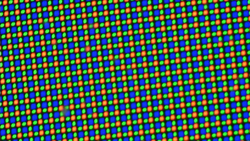
Galaxy S23 users who gaze at the Galaxy S24 are looking at a very similar panel that is marketed as Dynamic AMOLED 2X. However, the screen diagonal now measures 6.2 inches and comes with a stated peak brightness of 2,600 cd/m² as well as a minimum refresh rate of 1 Hz. We can confirm the former based on our measurement data.
The Galaxy S24's OLED panel has one of the highest brightness outputs in the smartphone segment. With a pure white background and activated ambient light sensor, the maximum brightness "only" hits 1,387 cd/m² but the display gets much brighter when it comes to an equal distribution of light and dark areas (APL18: 2,697 cd/m²). When playing 4K HDR pattern videos, we even measured 2,885 cd/m². In terms of the HDR standards, HLG, HDR10 as well as HDR10+ are included but not Dolby Vision.
Likewise, for anyone who likes it dark, the S24 is a suitable companion. At just 1.4 cd/m², the minimum display brightness is on a comparably low level that is undercut by another 0.4 cd/m² with the "Extra Dimming“ function.
The LTPO panel's refresh rate is dynamically adjusted between 1 and 120 Hz (manufacturer's info) or can be optionally limited to 60 Hz. However, the system states a minimum frequency of 24 Hz for the 120 Hz display with a constant 60 Hz being present in many applications such as YouTube or photo albums.
| |||||||||||||||||||||||||
Brightness Distribution: 97 %
Center on Battery: 1349 cd/m²
Contrast: ∞:1 (Black: 0 cd/m²)
ΔE Color 3.3 | 0.5-29.43 Ø5
ΔE Greyscale 2.4 | 0.57-98 Ø5.3
98.9% sRGB (Calman 2D)
Gamma: 1.97
| Samsung Galaxy S24 Dynamic AMOLED 2X, 2340x1080, 6.20 | Samsung Galaxy S23 Dynamic AMOLED 2x, 2340x1080, 6.10 | Xiaomi 14 OLED, 2670x1200, 6.36 | Apple iPhone 15 Super Retina XDR OLED, 2556x1179, 6.10 | Google Pixel 8 OLED, 2400x1080, 6.20 | |
|---|---|---|---|---|---|
| Screen | -12% | 14% | 8% | 17% | |
| Brightness middle | 1349 | 1125 -17% | 1043 -23% | 1046 -22% | 1450 7% |
| Brightness | 1369 | 1122 -18% | 1052 -23% | 1019 -26% | 1410 3% |
| Brightness Distribution | 97 | 96 -1% | 96 -1% | 94 -3% | 92 -5% |
| Black Level * | |||||
| Colorchecker dE 2000 * | 3.3 | 3.2 3% | 1.1 67% | 1.4 58% | 1.1 67% |
| Colorchecker dE 2000 max. * | 5 | 4.9 2% | 2.8 44% | 2.84 43% | 4.2 16% |
| Greyscale dE 2000 * | 2.4 | 3.3 -38% | 1.9 21% | 2.4 -0% | 2.1 12% |
| Gamma | 1.97 112% | 1.97 112% | 2.23 99% | 2.158 102% | 2.24 98% |
| CCT | 6635 98% | 6504 100% | 6740 96% | 6410 101% | 6584 99% |
* ... smaller is better
As a result of the installed OLED technology, Samsung uses the PWM modulation type including screen flickering to regulate the screen brightness. In our measurement with the oscilloscope, the amplitude curve is very uniform across the entire brightness spectrum and fluctuates constantly between 240 Hz and 480 Hz. We didn't record any conflicting results using a flicker meter which detects visually perceptible fluctuations in luminance.
Screen Flickering / PWM (Pulse-Width Modulation)
| Screen flickering / PWM detected | 483 Hz | ||
The display backlight flickers at 483 Hz (worst case, e.g., utilizing PWM) . The frequency of 483 Hz is relatively high, so most users sensitive to PWM should not notice any flickering. However, there are reports that some users are still sensitive to PWM at 500 Hz and above, so be aware. In comparison: 53 % of all tested devices do not use PWM to dim the display. If PWM was detected, an average of 17903 (minimum: 5 - maximum: 3846000) Hz was measured. | |||
A series of measurements with fixed zoom and various brightness settings.
The high-end phone has two color profiles. Anyone seeking the most accurate color and gray scale reproduction should select the "Natural" color mode as this doesn't allow any adjustment of the color temperature. The latter can only be tweaked using the "Vibrant" mode. As far as we're concerned, this compromise between the best screen calibration or personally preferred white representation is unnecessary.
We analysed the AMOLED panel's color reproduction using the Calman analysis software and a photo spectrometer. In our measurements using both color modes we recorded very low color deviations with the measured "Natural" color mode DeltaE values being somewhat higher than those found in a Xiaomi 14 or Google Pixel 8.
Display Response Times
| ↔ Response Time Black to White | ||
|---|---|---|
| 1.09 ms ... rise ↗ and fall ↘ combined | ↗ 0.591 ms rise | |
| ↘ 0.499 ms fall | ||
| The screen shows very fast response rates in our tests and should be very well suited for fast-paced gaming. In comparison, all tested devices range from 0.1 (minimum) to 240 (maximum) ms. » 2 % of all devices are better. This means that the measured response time is better than the average of all tested devices (21.5 ms). | ||
| ↔ Response Time 50% Grey to 80% Grey | ||
| 2.57 ms ... rise ↗ and fall ↘ combined | ↗ 1.379 ms rise | |
| ↘ 1.19 ms fall | ||
| The screen shows very fast response rates in our tests and should be very well suited for fast-paced gaming. In comparison, all tested devices range from 0.2 (minimum) to 636 (maximum) ms. » 7 % of all devices are better. This means that the measured response time is better than the average of all tested devices (33.7 ms). | ||
Outdoors, the Galaxy S24 makes a very positive impression and possesses sufficient brightness reserves to be able to cope with wintery lighting situations. But even under peak summer conditions, reflections will hardly restrict the AMOLED panel's legibility on the Gorilla Glass Victus 2 surface due to its tremendous luminance. However, if you wish to regulate the brightness manually, you will have a maximum of 420 cd/m² at your disposal. With the "Additional Brightness“ option, the brightness can be increased up to 775 cd/m².
Performance - The Galaxy S24 has a Samsung in-house SoC
After a one-year break and unlike its predecessor, Samsung has once more opted for its in-house chip solution in Europe and not the current flagship SoC from Qualcomm. The Exynos 2400 used in the Galaxy S24 uses the same ARM cortex cluster as a Qualcomm Snapdragon 8 Gen 3, albeit with a difference in the number of cores as well as the clock speed.
| CPU Architecture | Samsung Exynos 2400 | Qualcomm Snapdragon 8 Gen 3 for Galaxy |
|---|---|---|
| ARM Cortex X4 | 1 core - 3.2 GHz | 1 core - 3.39 GHz |
| ARM Cortex A720 | 2 cores - 2.9 GHz | 3 cores - 3.1 GHz |
| 3 cores - 2.6 GHz | 2 cores - 2.9 GHz | |
| ARM Cortex A520 | 4 cores - 1.95 GHz | 2 cores - 2.2 GHz |
In our series of CPU benchmarks, the Galaxy S24 orientates itself somewhat on the Galaxy S23 which relies on the Snapdragon 8 Gen 2 for Galaxy - the Exynos 2400 is rated more powerful, especially in the Geekbench multiscore. However, the Galaxy S24's single-core performance has only made slight improvements compared to its predecessor. A glance at the Ultra model and its Snapdragon 8 Gen 3 for Galaxy reveals the Exynos 2400 to have a lower performance level. However, given the additional Cortex A520 cores and the Samsung SoC's lower clock speed, this was to be expected.
What is somewhat difficult to understand is the RAM policy for the Galaxy S24. Of course, 8 GB of RAM are still sufficient in top-of-the-range phones, but, as far as we're concerned, a 12 GB version - especially considering the update guarantee up to 2031 - is a must. Particularly as 24 GB of RAM have already found their way into the upper mid-range.
| UL Procyon AI Inference for Android - Overall Score NNAPI | |
| Google Pixel 8 | |
| Average of class Smartphone (207 - 84787, n=150, last 2 years) | |
| Samsung Galaxy S24 Ultra | |
| Xiaomi 14 | |
| Samsung Galaxy S23 | |
| Samsung Galaxy S24 | |
| Average Samsung Exynos 2400 (11342 - 11574, n=2) | |
The Xclipse 940 iGPU integrated into the Exynos 2400 is based on the AMD RDNA 3 architecture. Unlike the Radeon 780M, the graphics unit found in the Galaxy S24 only possesses half the shader units.
In the graphics tests, the Xclipse 940 iGPU performed very well but sits in the 3DMark benchmark quite a bit behind the Adreno 750. The Ultra model's higher resolution puts the Galaxy S24's lower performance somewhat into perspective in the GFXBench onscreen values. However, somewhat surprisingly, the Adreno 750 sometimes performs better than the Xclipse 940 iGPU. At the end of the day, we're dealing with a slight increase in power compared to the Galaxy S23's Adreno 740.
GFXBench (DX / GLBenchmark) 2.7: T-Rex Onscreen | 1920x1080 T-Rex Offscreen
GFXBench 3.0: on screen Manhattan Onscreen OGL | 1920x1080 1080p Manhattan Offscreen
GFXBench 3.1: on screen Manhattan ES 3.1 Onscreen | 1920x1080 Manhattan ES 3.1 Offscreen
GFXBench: on screen Car Chase Onscreen | 1920x1080 Car Chase Offscreen | on screen Aztec Ruins High Tier Onscreen | 2560x1440 Aztec Ruins High Tier Offscreen | on screen Aztec Ruins Normal Tier Onscreen | 1920x1080 Aztec Ruins Normal Tier Offscreen | 3840x2160 4K Aztec Ruins High Tier Offscreen
| 3DMark / Wild Life Extreme Unlimited | |
| Samsung Galaxy S24 Ultra | |
| Xiaomi 14 | |
| Samsung Galaxy S24 | |
| Samsung Galaxy S23 | |
| Google Pixel 8 | |
| Apple iPhone 15 | |
| Samsung Galaxy S22 | |
| 3DMark / Wild Life Extreme | |
| Samsung Galaxy S24 Ultra | |
| Xiaomi 14 | |
| Samsung Galaxy S24 | |
| Samsung Galaxy S23 | |
| Google Pixel 8 | |
| Apple iPhone 15 | |
| Samsung Galaxy S22 | |
| 3DMark / Wild Life Unlimited Score | |
| Samsung Galaxy S24 Ultra | |
| Xiaomi 14 | |
| Samsung Galaxy S23 | |
| Samsung Galaxy S24 | |
| Apple iPhone 15 | |
| Google Pixel 8 | |
| Samsung Galaxy S22 | |
| 3DMark / Solar Bay Score | |
| Xiaomi 14 | |
| Samsung Galaxy S24 Ultra | |
| Samsung Galaxy S24 | |
| Samsung Galaxy S23 | |
| Apple iPhone 15 | |
| 3DMark / Solar Bay Unlimited Score | |
| Xiaomi 14 | |
| Samsung Galaxy S24 Ultra | |
| Samsung Galaxy S24 | |
| Samsung Galaxy S23 | |
| Apple iPhone 15 | |
| GFXBench (DX / GLBenchmark) 2.7 / T-Rex Onscreen | |
| Xiaomi 14 | |
| Samsung Galaxy S23 | |
| Google Pixel 8 | |
| Samsung Galaxy S24 Ultra | |
| Samsung Galaxy S22 | |
| Samsung Galaxy S24 | |
| Apple iPhone 15 | |
| GFXBench (DX / GLBenchmark) 2.7 / T-Rex Offscreen | |
| Samsung Galaxy S24 Ultra | |
| Xiaomi 14 | |
| Samsung Galaxy S23 | |
| Samsung Galaxy S24 | |
| Apple iPhone 15 | |
| Google Pixel 8 | |
| Samsung Galaxy S22 | |
| GFXBench 3.0 / Manhattan Onscreen OGL | |
| Xiaomi 14 | |
| Samsung Galaxy S23 | |
| Samsung Galaxy S24 Ultra | |
| Samsung Galaxy S22 | |
| Samsung Galaxy S24 | |
| Google Pixel 8 | |
| Apple iPhone 15 | |
| GFXBench 3.0 / 1080p Manhattan Offscreen | |
| Samsung Galaxy S24 Ultra | |
| Xiaomi 14 | |
| Samsung Galaxy S24 | |
| Samsung Galaxy S23 | |
| Samsung Galaxy S22 | |
| Apple iPhone 15 | |
| Google Pixel 8 | |
| GFXBench 3.1 / Manhattan ES 3.1 Onscreen | |
| Xiaomi 14 | |
| Samsung Galaxy S23 | |
| Samsung Galaxy S24 | |
| Samsung Galaxy S24 Ultra | |
| Samsung Galaxy S22 | |
| Google Pixel 8 | |
| Apple iPhone 15 | |
| GFXBench 3.1 / Manhattan ES 3.1 Offscreen | |
| Xiaomi 14 | |
| Samsung Galaxy S24 Ultra | |
| Samsung Galaxy S24 | |
| Samsung Galaxy S23 | |
| Apple iPhone 15 | |
| Samsung Galaxy S22 | |
| Google Pixel 8 | |
| GFXBench / Car Chase Onscreen | |
| Xiaomi 14 | |
| Samsung Galaxy S23 | |
| Samsung Galaxy S24 | |
| Samsung Galaxy S24 Ultra | |
| Samsung Galaxy S22 | |
| Apple iPhone 15 | |
| Google Pixel 8 | |
| GFXBench / Car Chase Offscreen | |
| Xiaomi 14 | |
| Samsung Galaxy S24 Ultra | |
| Samsung Galaxy S24 | |
| Samsung Galaxy S23 | |
| Apple iPhone 15 | |
| Google Pixel 8 | |
| Samsung Galaxy S22 | |
| GFXBench / Aztec Ruins High Tier Onscreen | |
| Samsung Galaxy S24 | |
| Samsung Galaxy S23 | |
| Xiaomi 14 | |
| Samsung Galaxy S24 Ultra | |
| Apple iPhone 15 | |
| Google Pixel 8 | |
| Samsung Galaxy S22 | |
| GFXBench / Aztec Ruins High Tier Offscreen | |
| Xiaomi 14 | |
| Samsung Galaxy S24 Ultra | |
| Samsung Galaxy S24 | |
| Samsung Galaxy S23 | |
| Apple iPhone 15 | |
| Google Pixel 8 | |
| Samsung Galaxy S22 | |
| GFXBench / Aztec Ruins Normal Tier Onscreen | |
| Xiaomi 14 | |
| Samsung Galaxy S23 | |
| Samsung Galaxy S24 | |
| Samsung Galaxy S24 Ultra | |
| Google Pixel 8 | |
| Samsung Galaxy S22 | |
| Apple iPhone 15 | |
| GFXBench / Aztec Ruins Normal Tier Offscreen | |
| Xiaomi 14 | |
| Samsung Galaxy S24 Ultra | |
| Samsung Galaxy S24 | |
| Samsung Galaxy S23 | |
| Apple iPhone 15 | |
| Google Pixel 8 | |
| Samsung Galaxy S22 | |
| GFXBench / 4K Aztec Ruins High Tier Offscreen | |
| Samsung Galaxy S24 Ultra | |
| Xiaomi 14 | |
| Samsung Galaxy S24 | |
| Samsung Galaxy S23 | |
| Apple iPhone 15 | |
| Google Pixel 8 | |
In terms of browser speed, the Samsung smartphone has no reason to hide. Websites load quickly and can be scrolled through smoothly. In the browser benchmarks, the Galaxy S24 delivered consistently good results.
| Jetstream 2 - Total Score | |
| Apple iPhone 15 (Chrome 117) | |
| Xiaomi 14 (Chrome 120.0.6099.210) | |
| Samsung Galaxy S23 (Chrome 109) | |
| Average Samsung Exynos 2400 (128.6 - 139.1, n=2) | |
| Samsung Galaxy S24 (Chrome 122) | |
| Average of class Smartphone (13.8 - 351, n=173, last 2 years) | |
| Google Pixel 8 (chrome 116) | |
| Speedometer 2.0 - Result | |
| Apple iPhone 15 (Chrome 117) | |
| Samsung Galaxy S24 (Chrome 122) | |
| Xiaomi 14 (Chrome 120.0.6099.210) | |
| Average Samsung Exynos 2400 (260 - 267, n=2) | |
| Samsung Galaxy S23 (Chrome 109) | |
| Google Pixel 8 (chrome 116) | |
| Average of class Smartphone (14.9 - 445, n=157, last 2 years) | |
| WebXPRT 4 - Overall | |
| Xiaomi 14 (Chrome 120.0.6099.210) | |
| Samsung Galaxy S24 (Chrome 122) | |
| Average Samsung Exynos 2400 (176 - 176, n=2) | |
| Samsung Galaxy S23 (Chrome 109) | |
| Average of class Smartphone (22 - 202, n=160, last 2 years) | |
| Google Pixel 8 (chrome 116) | |
| Octane V2 - Total Score | |
| Apple iPhone 15 (Chrome 117) | |
| Xiaomi 14 (Chrome 120.0.6099.210) | |
| Samsung Galaxy S24 (Chrome 122) | |
| Average Samsung Exynos 2400 (63452 - 63748, n=2) | |
| Samsung Galaxy S23 (Chrome 109) | |
| Google Pixel 8 (chrome 116) | |
| Average of class Smartphone (2228 - 89112, n=214, last 2 years) | |
| Mozilla Kraken 1.1 - Total | |
| Average of class Smartphone (388 - 9999, n=173, last 2 years) | |
| Google Pixel 8 (chrome 116) | |
| Samsung Galaxy S23 (Chrome 109) | |
| Samsung Galaxy S24 (Chrome 122) | |
| Average Samsung Exynos 2400 (631 - 662, n=2) | |
| Xiaomi 14 (Chrome 120.0.6099.210) | |
| Apple iPhone 15 (Chrome 117) | |
* ... smaller is better
Our 256 GB version's UFS 4.0 storage is very fast but, particularly when it comes to write speeds Samsung doesn't earn a top spot. However, this has less to do with the installed storage drive itself and has more to do with the Exynos 2400's memory controller. It is doubtful whether this performance deficit will really cause a noticeable difference in everyday loading speed.
| Samsung Galaxy S24 | Xiaomi 14 | Samsung Galaxy S24 Ultra | Average 256 GB UFS 4.0 Flash | Average of class Smartphone | |
|---|---|---|---|---|---|
| AndroBench 3-5 | 86% | 13% | 47% | -15% | |
| Sequential Read 256KB | 3701.23 | 3385.74 -9% | 3610.25 -2% | 3558 ? -4% | 1508 ? -59% |
| Sequential Write 256KB | 1435.39 | 2906.65 102% | 1893.63 32% | 2443 ? 70% | 1118 ? -22% |
| Random Read 4KB | 373.12 | 420.99 13% | 437.12 17% | 414 ? 11% | 247 ? -34% |
| Random Write 4KB | 175.98 | 594.78 238% | 181.55 3% | 367 ? 109% | 272 ? 55% |
| Samsung Galaxy S24 | Samsung Galaxy S23 | Xiaomi 14 | Google Pixel 8 | Samsung Galaxy S24 Ultra | Average 256 GB UFS 4.0 Flash | Average of class Smartphone | |
|---|---|---|---|---|---|---|---|
| PCMark for Android | 38% | 49% | -35% | 61% | 36% | -1% | |
| Storage 2.0 seq. read int. | 2345 ? | 2370.62 1% | 2452 ? 5% | 1627 ? -31% | 2787.27 19% | 2513 ? 7% | 1549 ? -34% |
| Storage 2.0 seq. write int. | 1108 ? | 2081.06 88% | 2817 ? 154% | 570 ? -49% | 2991.55 170% | 2232 ? 101% | 1315 ? 19% |
| Storage 2.0 random read int. | 50.9 ? | 50.91 0% | 29.6 ? -42% | 16 ? -69% | 60.38 19% | 40.6 ? -20% | 38.6 ? -24% |
| Storage 2.0 random write int. | 64.4 ? | 85.66 33% | 62.9 ? -2% | 39.7 ? -38% | 96.83 50% | 65 ? 1% | 59.7 ? -7% |
| Storage 2.0 | 21538 ? | 35786 66% | 49601 ? 130% | 24572 ? 14% | 32146 49% | 41309 ? 92% | 29868 ? 39% |
Games - The Samsung Galaxy S24 can hit 120fps
In order to be able to evaluate the Xclipse 940 iGPU's graphics power outside of benchmarks, we took a look at three PlayStore games using the GameBench application. After the predecessor got off to a somewhat shaky start, we were keen to discover to which extent HFR gaming is possible on the Galaxy S24.
For games that have low system requirements which theoretically allow HFR gaming up to 144 Hz (such as the first-person shooter Dead Trigger 2), the Galaxy S24 can occasionally reach the maximum supported 120 frames per second. Modern games such as PUBG Mobile, can be played at medium settings (HD setting) at 60fps. In the highest detail level (UHD) the Samsung phone runs at a constant 40fps. The 90fps option in the battle royale game's lowest graphics setting is also supported meaning the top-tier smartphone can hit 90fps with low details.
Our third game on the Galaxy S24, the demanding Genshin Impact, is displayed at 60fps using the highest graphics setting. If the fantasy-action RPG's level of detail is reduced, the frame rate - typical for Android - also remains at 60 frames per second.
Emissions - The Samsung smartphone gets really warm
Temperature
In our measurements, the surface temperatures were quite high, especially considering the Burnout benchmark stopped running due to overheating under full load (CPU + GPU). This means our test only took place under easier conditions (CPU).
Additionally, we also ran the 3DMark stress tests which experienced moderate to heavy throttling of over 40 percent after 30 runs. As a result, in the area of SoC throttling, the Galaxy S24 is on the same level as its predecessor, but on a slightly higher performance level. Likewise, the GFXBench benchmark battery test (ES3.1) ran without problems but will leave its users in the dark regarding the results with an error message ("Out of Memory").
(±) The maximum temperature on the upper side is 43.4 °C / 110 F, compared to the average of 35 °C / 95 F, ranging from 21.9 to 56 °C for the class Smartphone.
(±) The bottom heats up to a maximum of 44 °C / 111 F, compared to the average of 33.8 °C / 93 F
(+) In idle usage, the average temperature for the upper side is 25.9 °C / 79 F, compared to the device average of 32.7 °C / 91 F.
3DMark Wild Life stress test
| 3DMark | |
| Wild Life Stress Test Stability | |
| Google Pixel 8 | |
| Apple iPhone 15 | |
| Samsung Galaxy S24 | |
| Samsung Galaxy S23 | |
| Wild Life Extreme Stress Test | |
| Apple iPhone 15 | |
| Google Pixel 8 | |
| Samsung Galaxy S24 | |
| Samsung Galaxy S23 | |
| Solar Bay Stress Test Stability | |
| Xiaomi 14 | |
| Apple iPhone 15 | |
| Samsung Galaxy S24 | |
Speakers
The Galaxy S24 relies on an AKG-optimized dual-loudspeaker system with Dolby Atmos support and a powerful soundstage – we measured a maximum volume of over 91 dB. The Samsung smartphone cannot handle deep tones, however, there is a definite touch of bass. Our pink noise measurement displayed a very similar frequency curve to that of the Galaxy S23 meaning we are probably dealing with the same hardware.
Anyone wishing to use external sound output can do so via the wired USB port or wirelessly via Bluetooth 5.3. The latter has a comparatively small number of codecs (SBC, AAC, aptX, LDAC and SSC) at its disposal.
Samsung Galaxy S24 audio analysis
(+) | speakers can play relatively loud (91.4 dB)
Bass 100 - 315 Hz
(-) | nearly no bass - on average 22.1% lower than median
(+) | bass is linear (6.2% delta to prev. frequency)
Mids 400 - 2000 Hz
(±) | reduced mids - on average 5.3% lower than median
(+) | mids are linear (5% delta to prev. frequency)
Highs 2 - 16 kHz
(±) | higher highs - on average 5.3% higher than median
(+) | highs are linear (3.1% delta to prev. frequency)
Overall 100 - 16.000 Hz
(±) | linearity of overall sound is average (16.1% difference to median)
Compared to same class
» 3% of all tested devices in this class were better, 4% similar, 93% worse
» The best had a delta of 12%, average was 38%, worst was 134%
Compared to all devices tested
» 21% of all tested devices were better, 5% similar, 74% worse
» The best had a delta of 4%, average was 25%, worst was 134%
Samsung Galaxy S23 audio analysis
(+) | speakers can play relatively loud (91.5 dB)
Bass 100 - 315 Hz
(-) | nearly no bass - on average 22.5% lower than median
(+) | bass is linear (6.1% delta to prev. frequency)
Mids 400 - 2000 Hz
(±) | reduced mids - on average 5.8% lower than median
(+) | mids are linear (3.9% delta to prev. frequency)
Highs 2 - 16 kHz
(+) | balanced highs - only 4.5% away from median
(+) | highs are linear (1.8% delta to prev. frequency)
Overall 100 - 16.000 Hz
(±) | linearity of overall sound is average (16.2% difference to median)
Compared to same class
» 4% of all tested devices in this class were better, 4% similar, 93% worse
» The best had a delta of 12%, average was 38%, worst was 134%
Compared to all devices tested
» 21% of all tested devices were better, 5% similar, 74% worse
» The best had a delta of 4%, average was 25%, worst was 134%
Battery runtimes - The Galaxy S24 comes with a large battery
Power consumption
Wired charging is still only possible at 25 watts (Galaxy S23: 25-watt) and a sufficiently fast charger is not included. With a powerful energy source (Powerbank, 100-watt, PD 3.0), we were able to completely recharge the Samsung smartphone within 85 minutes - after roughly half an hour this is 50 percent. Wireless charging is possible at up to 15 watts and, additionally, with the help of Wireless PowerShare, headphones or a smartwatch can be charged via the Galaxy S24.
Running idle at an average of around 1 watt, the Samsung cell phone's power consumption is decent but the predecessor and its Qualcomm SoC used a little less energy. As expected, the power consumption under load is significantly higher than the Galaxy S23 given the Burnout benchmark. At over 16 watts, the Exynos chipset consumes a lot of power compared to a Xiaomi 14.
Moreover, the Galaxy S24 stands out for having very high consumption in standby mode. Overnight, the energy storage device sometimes loses between 6 and 8 percentage points, without even having been used.
| Off / Standby | |
| Idle | |
| Load |
|
| Samsung Galaxy S24 4000 mAh | Samsung Galaxy S23 3900 mAh | Xiaomi 14 4610 mAh | Apple iPhone 15 3349 mAh | Google Pixel 8 4575 mAh | Average Samsung Exynos 2400 | Average of class Smartphone | |
|---|---|---|---|---|---|---|---|
| Power Consumption | 28% | 17% | -9% | 7% | 8% | -22% | |
| Idle Minimum * | 0.42 | 0.57 -36% | 0.51 -21% | 0.9 -114% | 0.56 -33% | 0.425 ? -1% | 0.897 ? -114% |
| Idle Average * | 0.93 | 0.74 20% | 0.89 4% | 1 -8% | 1.08 -16% | 0.885 ? 5% | 1.452 ? -56% |
| Idle Maximum * | 1.07 | 0.83 22% | 0.92 14% | 1.1 -3% | 1.17 -9% | 1.01 ? 6% | 1.629 ? -52% |
| Load Average * | 15.43 | 4.26 72% | 9.08 41% | 6 61% | 8.01 48% | 11.1 ? 28% | 5.55 ? 64% |
| Load Maximum * | 16.51 | 6.16 63% | 9.11 45% | 13.6 18% | 8.89 46% | 16.5 ? -0% | 8.31 ? 50% |
* ... smaller is better
Power consumption: Geekbench (150 cd/m²)
Power consumption: GFXBench (150 cd/m²)
Battery life
The Galaxy S24's energy pack delivers 100 mAh more than the battery found in the predecessor (3,900 mAh). We performed our real-world test using adaptive display brightness set to 150 cd/m² and the Galaxy phone scored very well. However, this highlights the less efficient runtimes of the Exynos 2400 compared to the Snapdragon 8 Gen 2-powered predecessor.
But, we should put the low values under load into perspective. With the Galaxy S24, we implemented our new test procedure (Burnout benchmark) and not, as previously, the "Stability Test" application. The latter is no longer supported by Android 14.
| Samsung Galaxy S24 4000 mAh | Samsung Galaxy S23 3900 mAh | Xiaomi 14 4610 mAh | Apple iPhone 15 3349 mAh | Google Pixel 8 4575 mAh | |
|---|---|---|---|---|---|
| Battery Runtime | 34% | 39% | 31% | -1% | |
| Reader / Idle | 2398 | 2249 -6% | 2926 22% | 2698 13% | 1493 -38% |
| H.264 | 1227 | 1255 2% | 1674 36% | 1305 6% | 1363 11% |
| WiFi v1.3 | 880 | 926 5% | 1092 24% | 1002 14% | 814 -7% |
| Load | 159 | 370 133% | 277 74% | 306 92% | 205 29% |
Pros
Cons
Verdict - Samsung Galaxy S24
The Galaxy S24 is compact, light and comes with a very premium feel. With its great update policy, Samsung has provided an additional selling point for its high-end smartphone. But, these are virtues already shared with the Galaxy S23 and, from a software point of view, both Galaxy models will be similar after receiving an update to One UI 6.1 which includes Galaxy AI. Sure, the Galaxy S24 possesses a brighter display, the guarantee of longer updates and a touch more power than its predecessor but, considering the installed hardware, the 2024 model gives off the impression of stagnation in the Samsung universe rather than a consistent further development. The Exynos 2400 used in Europe is certainly neither a "problem" nor a deal breaker but the Samsung chipset is not free of criticism. In particular, the high power consumption paired with the pronounced heat dissipation is responsible for shorter battery life than the competing devices. In this area, a Xiaomi 14 has significantly better staying power and makes a more modern impression than Samsung's high-end device thanks to the Snapdragon 8 Gen 3, WiFi 7, Bluetooth 5.4 as well as high-level charging performance.
The Samsung Galaxy S24 is still the best compact smartphone the Android camp has to offer. Nevertheless, the predecessor's small number of weaknesses haven't been addressed and are still present in this generation.
Appropriate for this price category, we would hope that the top version of a Galaxy S25 comes with 12 GB of RAM and 512 GB of internal storage. On top of that, Samsung should look to the competition for inspiration when it comes to display settings and the selection of Bluetooth codecs.
Anyone who considers the Galaxy S24's update policy to be a strong selling point will find an additional, relatively compact alternative in the form of the Google Pixel 8. With Google's top-end device having been on the market for some time, the Pixel 8 can be purchased for significantly cheaper prices.
Price and availability
The Samsung Galaxy S24 starts with an RRP of $799 and can be purchased on the Samsung online store. Additionally, for a limited time, the S24 is available for $699 on Amazon.com.
Samsung Galaxy S24
-
03/07/2024 v7
Marcus Herbrich
Transparency
The present review sample was made available to the author as a loan by the manufacturer or a shop for the purposes of review. The lender had no influence on this review, nor did the manufacturer receive a copy of this review before publication. There was no obligation to publish this review.


 Deutsch
Deutsch English
English Español
Español Français
Français Italiano
Italiano Nederlands
Nederlands Polski
Polski Português
Português Русский
Русский Türkçe
Türkçe Svenska
Svenska Chinese
Chinese Magyar
Magyar